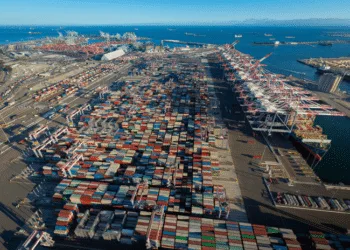If the current freight climate continues, a number of freight brokerages—many of them large—will likely fail over the next year.
The current market presents a toxic combination of sluggish freight volumes and firming spot rates, which is the worst possible environment for freight brokers.
Understanding the Market Dynamics
Freight brokerages act as intermediaries between shippers and carriers, profiting from the margins between contract rates (what they charge shippers) and spot rates (what they pay carriers for immediate loads).
Brokers generally thrive under specific conditions:
- Low volumes with declining spot rates
- Stable volumes and rates
- High volumes with declining spot rates
- High volumes with surging spot rates
However, the current environment—characterized by low volumes and rising spot rates—flips this script, squeezing margins and exposing vulnerabilities.
Spot rates have been climbing as the compliance crackdown continues, taking bottom-feeder capacity out of the market. This is generating marginal increases in spot rates as the bottom of the market is washed out. But market conditions lack strong underlying support, with tender volumes down roughly 20% year-over-year and rejection rates remaining flat.
This softness in demand is compounded by gradual capacity tightening in the spot truckload market, where freight volumes remain weak amid a goods recession that is further eroding.
Normally, when spot rates increase, it happens because volumes are increasing relative to recent conditions. This demand shock allows brokers to reset their rates with their shippers, knowing that the shippers don’t have a ton of alternatives.
In this climate, that isn’t possible. Due to slow volumes, large asset carriers have plenty of available capacity and are willing to accept the loads on offer, so long as the rates are nominally higher than where they’ve been trending.
The general rates in the spot market haven’t increased substantially, but the bottom of the market is being eliminated, as it was mostly represented by motor carriers that weren’t compliant and were willing to violate the rules, such as driving 18-hour days, even when the rules state that a driver can only log 11 hours.
Those carriers are being eliminated through the compliance crackdown, and rates are slowly trending up to a place where an asset-based carrier is willing to take the load.
Furthermore, shippers that FreightWaves has spoken with in recent weeks have told us that they are starting to favor using asset-based truckload carriers due to the fact that those carriers have more control over who is hauling their freight. With the Feds cracking down on compliance, this trend is likely to continue.
The Leverage Trap and Credit Crunch
Many mid-market brokers amplified their risks by leveraging earnings 8-10 times through credit facilities, often tied to covenants requiring maintained gross margin percentages. As margins compress due to the need to absorb higher spot rates without passing costs to shippers, these brokers face repayment demands that could push them toward insolvency.
I spoke with the CEO of a very large freight broker who told me that he is tracking dozens of companies that are effectively insolvent, but he is unable to acquire them, as the debt far exceeds what the business is worth.
With weak market volumes and an absence of high spot rips, a rebound is very unlikely.
Signs of a gradual rebound include rising tender rejection rates and improving spot rates compared to 2022-2023 lows, but these improvements come too late for over-leveraged players.
Truckload capacity is falling faster than demand, leading to higher rejection rates and spot rates, but this tightening hasn’t yet translated into surging volumes that could provide brokers with lucrative “rips” to offset losses.
Broader Implications for the Industry
The potential wave of brokerage failures could reshape the freight landscape. Asset-based carriers, with their direct control over trucks and capacity, are better positioned to weather low-volume periods by reclaiming business from struggling brokers. Shippers, meanwhile, may face disruptions if their brokerage partners fold, forcing them to renegotiate contracts amid rising rates influenced by tariffs and market volatility.
Looking Ahead: Strategies for Survival
The combination of weak volumes and firming rates leaves brokers with tough choices: accept thinner margins, return loads and risk losing clients, or face financial ruin. Without a swift turnaround in market conditions—such as a spike in volumes or a dip in spot rates—the freight brokerage sector could see significant consolidation through failures in the coming year.
Companies that sell into the freight brokerage industry are also at risk, as distressed brokers will likely struggle to pay their bills. This could have a knock-on effect for the freight tech industry that can only be solved by a resurgence of volumes in the goods economy.
The post The Perfect Storm: Why freight brokerages face a wave of failures in 2026 appeared first on FreightWaves.







 (@FreightAlley) November 3, 2025
(@FreightAlley) November 3, 2025

















